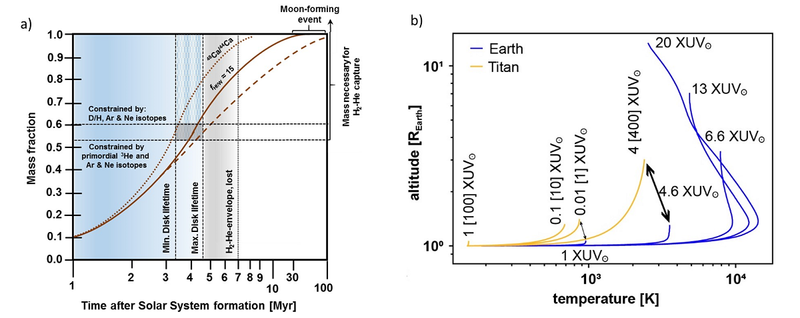Comparative aeronomy and the evolution of Earth-like habitats

In this research area, we focus on the interaction processes of solar/stellar radiation and plasma to the upper atmospheres of terrestrial planets and bodies without atmospheres (e.g., Mercury, the Moon and other satellites, comets, asteroids, and planetary embryos). The evolution of planetary atmospheres from primordial, steam to secondary atmospheres is studied. The origin and escape of exospheres from airless bodies, and the effects on surface compositional modification are also investigated. Variations of isotopes and volatile elements in different planetary reservoirs keep information about atmospheric escape, composition and even the source of accreting material.

Secondary atmospheres are studied in the framework of comparative planetology with a focus on aeronomical processes between Venus, Mars, Earth and terrestrial exoplanets. For studying the evolutionary processes, known atmospheric isotope and elemental ratios are used for evolutionary reproduction attempts. Atmospheric 36Ar/38Ar and D/H ratios, for instance, give important insights into the evolution of the Martian atmosphere (see schematic illustration) and its potential former habitability (for detailed information see, e.g., Scherf and Lammer 2021, and Lichtenegger et al. 2022). For Venus, the strong fractionation in its atmosphere shows that high amounts of H2O must have been lost into space over its history (see, e.g., Gillmann et al. 2022).
A better knowledge on how Earth’s atmosphere and biosphere originated and evolved will also enhance our understanding of exoplanetary systems, in particular in view of the potential habitability of Earth-type exoplanets. How so-called Earth-like Habitats, i.e., rocky exoplanets with N2-O2-dominated atmospheres and minor amounts of CO2, emerge and evolve, together with their prevalence in the Galaxy, is one of the key questions that the group tries to investigate.

Our group also studies the formation of Mercury’s exosphere as originated through the solar plasma and radiation environment (Lammer et al. 2022). It further investigates similar processes at icy satellites and comets. This research is carried out with the help of ESA’s BepiColombo mission with its PICAM (Planetary Ion Camera) and SERENA (Search for Exospheric Refilling & Emitted Natural Abundances) instruments, and Jupiter’s Icy Moon Explorer (JUICE) and Comet Interceptor.

For further information, please contact:
Dr. Helmut Lammer
Mag. Manuel Scherf
Dr. Ali Varsani (BepiColombo/PICAM)
Literature
Lammer H., B. Marty, A. Zerkle, M. Blanc, H. O'Neill and T. Klein, Eds., Reading Terrestrial Planet Evolution In Isotopes And Element Measurements, Springer, The Netherlands, 445 p., 2021.
Scherf M. and H. Lammer, Did Mars possess a dense atmosphere during the first ∼400 million years? Space Sci. Rev., 217, 2, 2021.
Gillmann, C., M.J. Way, G. Avice, D. Breuer, G.J. Golabek, D. Honing, J. Krissansen-Totton, H. Lammer, A.-C. Plesa, M. Persson, J.G. O'Rourke, A. Salvador, M. Scherf, and M.Y. Zolotov,The long-term evolution of the atmosphere of Venus: Processes and feedback mechanisms. Space Sci. Rev., 218, 56, 2022.
Lichtenegger H. I. M., S. Dyadechkin, M. Scherf, H. Lammer, R. Adam, E. Kallio, U. V. Amerstorfer and R. Jarvinen, Non-thermal escape of the Martian CO2 atmosphere over time: Constrained by Ar isotopes, Icarus, 382, 115009, 2022.
Lammer H., M. Scherf, Y. Ito, A. Mura, A. Vorburger, E. Guenther, P. Wurz, N. V. Erkaev and P. Odert, The exosphere as a boundary: Origin and evolution of airless bodies in the inner solar system and beyond including planets with silicate atmospheres, Space Sci. Rev., 218, 15, 2022.